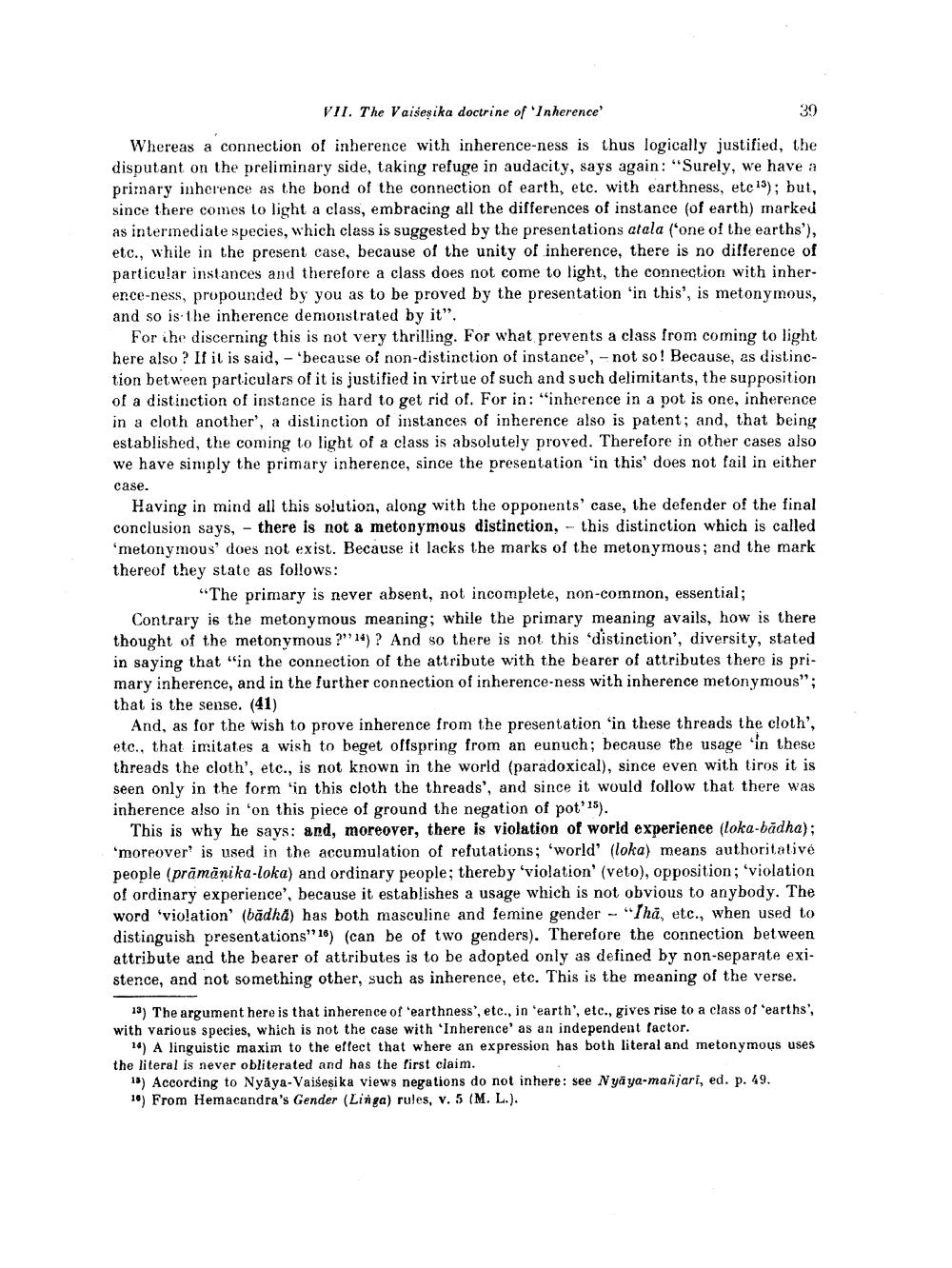________________
VII. The Vaisesika doctrine of Inherence'
Whereas a connection of inherence with inherence-ness is thus logically justified, the disputant on the preliminary side, taking refuge in audacity, says again: "Surely, we have a primary inherence as the bond of the connection of earth, etc. with earthness, etc 13); but, since there comes to light a class, embracing all the differences of instance (of earth) marked as intermediate species, which class is suggested by the presentations atala (one of the earths'), etc., while in the present case, because of the unity of inherence, there is no dillerence of particular instances and therefore a class does not come to light, the connection with inherence-ness, propounded by you as to be proved by the presentation 'in this', is metonymous, and so is the inherence demonstrated by it".
For ihe discerning this is not very thrilling. For what prevents a class from coming to light here also ? If it is said, -'because of non-distinction of instance', - not so! Because, as distinction between particulars of it is justified in virtue of such and such delimitants, the supposition of a distinction of instance is hard to get rid of. For in: "inherence in a pot is one, inherence in a cloth another', a distinction of instances of inherence also is patent; and that being established, the coming to light of a class is absolutely proved. Therefore in other cases also we have simply the primary inherence, since the presentation in this does not fail in either case.
Having in mind all this solution, along with the opponents' case, the defender of the final conclusion says, - there is not a metonymous distinction, - this distinction which is called ‘metonymous' does not exist. Because it lacks the marks of the metonymous; and the mark thereof they state as follows:
"The primary is never absent, not incomplete, non-common, essential; Contrary is the metonymous meaning; while the primary meaning avails, how is there thought of the metonymous ?"24) ? And so there is not this distinction', diversity, stated in saying that "in the connection of the attribute with the bearer of attributes there is primary inherence, and in the further connection of inherence-ness with inherence metonymous"; that is the sense. (41)
And, as for the wish to prove inherence from the presentation in these threads the cloth', etc., that imitates a wish to beget offspring from an eunuch; because the usage 'in these threads the cloth', etc., is not known in the world (paradoxical), since even with tiros it is seen only in the form 'in this cloth the threads', and since it would follow that there was inherence also in 'on this piece of ground the negation of pot'15).
This is why he says: and, moreover, there is violation of world experience (loka-bädha); 'moreover is used in the accumulation of refutations; 'world' (loka) means authoritative people (prāmānika-loka) and ordinary people; thereby 'violation' (veto), opposition; 'violation of ordinary experience', because it establishes a usage which is not obvious to anybody. The word 'violation' (bädha) has both masculine and femine gender - "Thã, etc., when used to distinguish presentations'' 16) (can be of two genders). Therefore the connection between attribute and the bearer of attributes is to be adopted only as defined by non-separate existence, and not something other, such as inherence, etc. This is the meaning of the verse.
18) The argument here is that inherence of earthness', etc., in earth', etc., gives rise to a class of 'earths' with various species, which is not the case with 'In herence' as an independent factor.
1) A linguistic maxim to the effect that where an expression has both literal and metonymous uses the literal is never obliterated and has the first claim.
15) According to Nyāya-Vaisesika views negations do not inhere: see Nya ya-manjari, ed. p. 49. 16) From Hemacandra's Gender (Linga) rules, v. 5 (M. L.).




